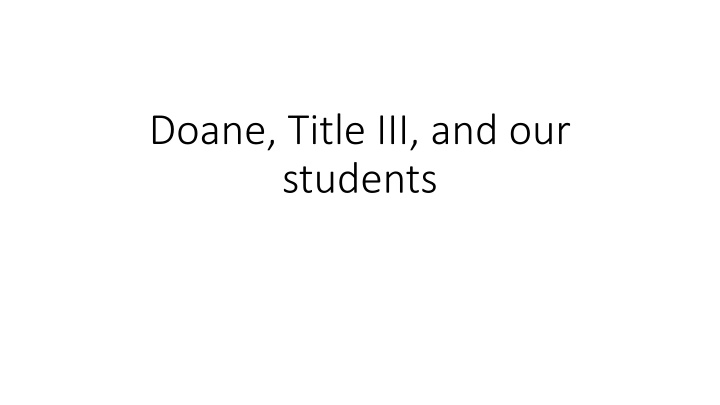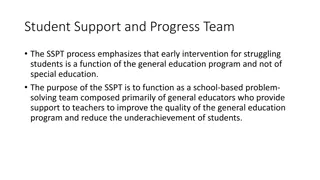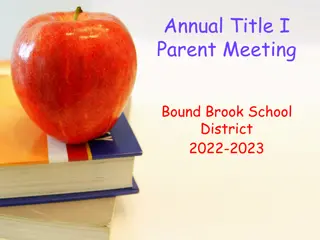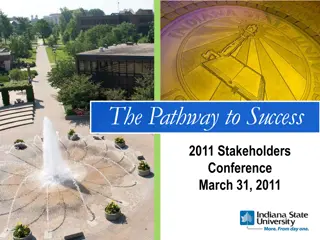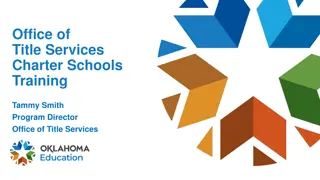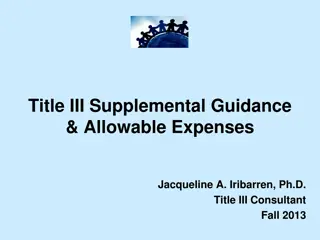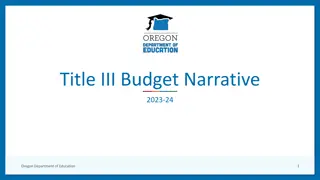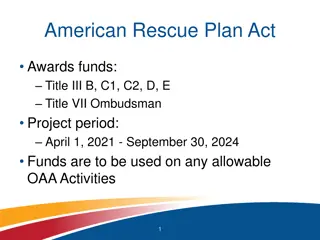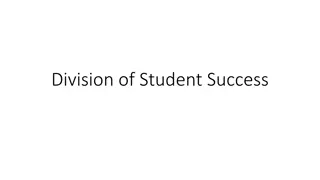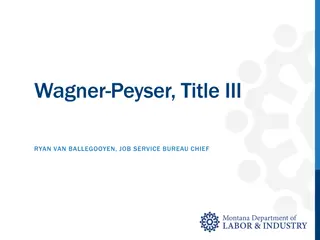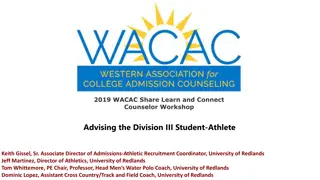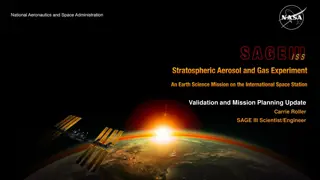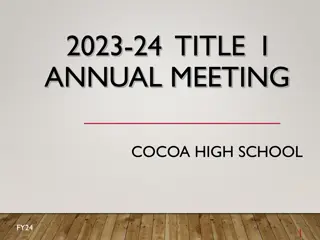Enhancing Student Success Through Title III Program
The Title III program, administered by the Federal Department of Education, aims to strengthen institutions serving Pell-eligible students. Grant activities focus on improving institutional operations and student retention to enhance academic success. Proposal development involves self-study and data-driven decision-making, with a committee overseeing the process. The program targets key areas such as wellness, academic support, minority student success, and faculty development to foster an inclusive community of learners. By retaining more students and supporting academic achievement, the university aims to create a supportive environment for both faculty and students, ultimately leading to increased revenue and successful graduation rates.
Download Presentation

Please find below an Image/Link to download the presentation.
The content on the website is provided AS IS for your information and personal use only. It may not be sold, licensed, or shared on other websites without obtaining consent from the author.If you encounter any issues during the download, it is possible that the publisher has removed the file from their server.
You are allowed to download the files provided on this website for personal or commercial use, subject to the condition that they are used lawfully. All files are the property of their respective owners.
The content on the website is provided AS IS for your information and personal use only. It may not be sold, licensed, or shared on other websites without obtaining consent from the author.
E N D
Presentation Transcript
Doane, Title III, and our students
What is Title III program? Federal Department of Education, designated by legislation Strengthening Institutions Program (SIP) Aimed at strengthening institutions that serve significant population of Pell-eligible students To apply for Title III funding in 2015, at least 46% of our students had to be Pell-eligible
Overall Requirements of Title III Program The Title III program requires that your grant activities have two overarching aims regardless of your specific proposal: 1. Strengthen the operation of your institution to continue serving Pell-eligible students 2. Improve standard retention and graduation rates we are required to report to IPEDS even if not relevant to proposal
Proposal development Self-study: required component of proposal process to identify strengths and weaknesses Committee of 5: Kate Marley, Becky Hunke, Heather Lambert, Susan Rocker and Julie Pinnell Data: local and national surveys, census reports, meetings across university for feedback, ideas and discovery of secret data caches!
What did we propose? Institutional: Supporting data collection, and Improved access to data for data-based decision-making CAS Focus 1: Wellness, alcohol norming, education and intervention CPS Focus 1: Academic Support Center, 2 staff positions Focus 2: Minority student success with peer mentoring, peer tutoring, and faculty development Focus 2: Professional development resources for faculty and staff
For the university: 1. Retaining more students means more revenue 2. Supporting an inclusive community of learners is our MISSION How does this work matter? For faculty: 1. Sense of belonging, mentoring, tutoring, support higher acad. achievement 2. Better work=happier grading! 3. Sober students learn better! For students: 1. Support, community, belonging, academic success 2. Normalized alcohol use that doesn t undermine goals 3. Earn credits and graduate, less debt
TITLE III: CPS UG % STUDENT ANNUAL MATRICULANTS RETAINED TO FOLLOWING AUTUMN GOAL Matriculating with 1-29 transfer credits ACTUAL Matriculating with 1-29 transfer credits PERCENT RETAINED FIRST YEAR TO SECOND YEAR 100 GOAL Matriculating with 0 transfer credits ACTUAL Matriculating with 0 transfer credits 90 80 70 60 50 40 30 20 10 0 2014 BASELINE 2015-2016 Y1 2016-2017 Y2 2017-2018 Y3 2018-2019 Y4 2019-2020 Y5
College of Arts and Sciences self study Table 3. A&S Retention and Graduation Rates by Gender and Race 1st-to-2nd Year Retention (2013 cohort) 72.0% 78.1% 66.7% 71.6% 66.3% 4-Yr Graduation (2010 Cohort) 6-Yr Graduation (2008 Cohort) Category of A&S Student All Students Female Male White Under-Represented Minorities Source: Doane 2014 Office of Institutional Research 52.9% 63.9% 39.6% 50.5% 30.5% 58.10% 69.2% 49.6% 54.5% 52.2%
Minority student support Tiger Success Mentoring Students selected based on accumulation of risk factors race/ethnicity, out of state, low ACT, HS GPA Peer support for thriving at a white institution, social navigation Academic skills, time management Mentors meet weekly with director on message for week and problem solving concerns for their mentees Valuable growth for mentors as well
Minority Student Support Study Helpdesk Drop in peer tutoring Learning Commons Library Sunday-Thursday 7-10pm All students welcome 8 highest demand subjects Accounting Biology Chemistry Economics Mathematics Physics Psychology Sociology Use higher in fall than spring
Minority student retention New this year Tiger Success Peer Mentoring expanded for all students supported in Academic Success And Wilma Jackson has a Student Affairs Grant for First Generation students, connect with Tiger Success
Between 2012 and 2015 Interterm was ended So while fewer male students may have consumed 5 or more drinks 3 times or more times in the past 2 weeks, more than 50% of male drinkers were drinking 5 or more drinks when they did drink. The median of 5 drinks in 2015 hides the fact that Doane male drinkers median was 9 drinks. Climate of heavy alcohol use COMPARED TO THE NATIONAL REFERENCE GROUP, Doane s drinking levels were way beyond normal college heavy alcohol consumption.
Heavy alcohol consumption and college success Heavy drinking interferes with successful college goal setting and achievement First year students and male students are the most susceptible to messages that they need to drink to fit in Students drinking heavily and at high frequency are much more likely to leave college
Alcohol Norming Campaign Students regularly believe that more of their peers drink much more alcohol than they do Norming: Ask students on a survey what percentage of their peers drink, and then provide the actual survey results immediately to the students Real time results indicate the actual percentage who drink and who abstain Students who know the real drinking norms on their campus are much more likely to chose NOT to drink, OR to drink LESS
Remainder of programming Wellness Student Wellness Action Team Healthy give-aways, games and wellness messages, alcohol education tucked in everywhere Alcohol education portion sizes, harm reduction Alcohol-free weekend social events that are crazy fun Direct programming for campus organizations, Greeks, Athletics Brief motivational interviewing and counseling for students dealing with alcohol/substance abuse or violations
Title III results normalizing drinking frequency Choosing healthy is normal Not drinking is normal Drinking responsibly is normal Getting black-out drunk is NOT normal
Climate of normalized alcohol use - improved retention of male students
Other evidence of changes in Climate for Alcohol Consumption Changes in student behaviors fewer BASICS appts Students electively requesting BASICS appts Popularity of SWAT program, Wellness Wednesdays
Institution-wide Data Strategy Director of Institutional Effectiveness Initial focus on helping grant staff collect appropriate data in effective ways Also helped develop QI project for HLC Currently supporting IT improvements to IDEA implementation Eventually will be able to provide more support for a variety of assessment work across the university, has expertise and passion in qualitative methods, also strong in quantitative methods
Why does this work matter? Students cannot be successful academically unless they: Feel like they belong on campus and in their classes regardless of skin color Keep their drinking at a level that does not interfere with their goals Limit their heavy drinking frequency so they can get their homework done Recognize and match normal drinking Are respected by faculty and peers Have access to support services that they need to succeed academically
Part 2 The role of faculty and advisors What faculty can do to support minority students and male students?
